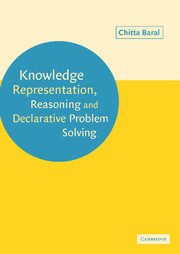Book contents
- Frontmatter
- Contents
- Preface
- 1 Declarative programming in AnsProlog*: introduction and preliminaries
- 2 Simple modules for declarative programming with answer sets
- 3 Principles and properties of declarative programming with answer sets
- 4 Declarative problem solving and reasoning in AnsProlog*
- 5 Reasoning about actions and planning in AnsProlog*
- 6 Complexity, expressiveness, and other properties of AnsProlog* programs
- 7 Answer set computing algorithms
- 8 Query answering and answer set computing systems
- 9 Further extensions of and alternatives to AnsProlog*
- Appendix A Ordinals, lattices, and fixpoint theory
- Appendix B Turing machines
- Bibliography
- Index of notation
- Index of terms
Appendix B - Turing machines
Published online by Cambridge University Press: 13 August 2009
- Frontmatter
- Contents
- Preface
- 1 Declarative programming in AnsProlog*: introduction and preliminaries
- 2 Simple modules for declarative programming with answer sets
- 3 Principles and properties of declarative programming with answer sets
- 4 Declarative problem solving and reasoning in AnsProlog*
- 5 Reasoning about actions and planning in AnsProlog*
- 6 Complexity, expressiveness, and other properties of AnsProlog* programs
- 7 Answer set computing algorithms
- 8 Query answering and answer set computing systems
- 9 Further extensions of and alternatives to AnsProlog*
- Appendix A Ordinals, lattices, and fixpoint theory
- Appendix B Turing machines
- Bibliography
- Index of notation
- Index of terms
Summary
Turing machines
This appendix is based on [Pap94] and it is recommended that the reader refer to that for detailed exposition on Turing machines, and computational complexity.
Intuitively, a deterministic Turing machine (DTM) is an automata bundled with a semi-infinite tape with a cursor to read from and write to. So, like an automata, there is a state and state transitions are based on the current state and what the cursor points to on the tape. But in addition to the state transition, there is an accompanying transition that dictates if the symbol in the tape location pointed to by the cursor should be overwritten and if the cursor should move to the left or right – by one cell – of its current position. Special symbols mark the beginning of the tape (>), the end of the input on the tape (⊔), and the output of the computation (‘halt’, ‘yes’, ‘no’). We now give a formal definition of DTMs.
Definition 151 A DTM is a quadruple M = (S, Σ, δ, s0) where S is a finite set of nonfinal states that includes s0 the initial state, Σ is a finite alphabet of symbols including the special symbols > and ⊔, and δ is a transition function that maps S × Σ to S ∪ {halt, yes, no} × Σ × {←, →, –}
Intuitively, δ is the control (or the program) of the machine that dictates how the machine behaves.
- Type
- Chapter
- Information
- Publisher: Cambridge University PressPrint publication year: 2003



